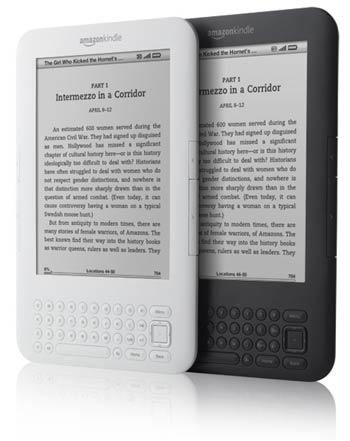The e-reader market is heating up but there are also signs that the industry is trying hard to pin down what’s next. What’s next is color, social networking and for some, video and interactivity.
FoxIt, a maker of wonderfully bloat-free PDF software, is ditching its e-reader efforts and retiring the eSlick. Sure, it’s a sign of Amazon’s unstoppable market power; Kindle 3 is pre-sold-out even weeks before it ships, taking much of the wind out of the eSlick’s sails. But it could also be a realization that monochrome e-ink technology’s days are numbered.
Proof is coming in from all angles. During the Kindle 3 announcement hubbub, Steve Kessel, Amazon’s vice president of Worldwide Digital Media, told Pocket-lint that Qualcomm’s low-power, video capable color Mirasol e-reader display technology “is in the lab.” Though downplaying it as Amazon’s tradition of testing a variety of potentially promising technologies, the admission gels with hints from Qualcomm’s reps to expect some announcements down the pike, potentially as early as this year. Given the timing of the Kindle 3’s release, however, chances of a color Kindle in 2010 are slim.
Meanwhile, Notion Ink is prepping an Android-powered tablet/e-reader called Adam, decked out with an ARM Cortex A9 processor with a Pixel Qi screen. What’s notable about this combo is that owners of the tablet will be able to switch between the rich, full-color experience that LCD provides (with surprisingly good outdoor image quality) to a grayscale, e-ink-like experience to conserve power.
Then there’s Copia, which plans to spice things up with both color and a dash of social networking. Sure, Amazon introduced some social networking hooks with the Kindle’s new Facebook and Twitter integration, but Copia has bigger plans. The company is planning to add rich, online book community and recommendation engine goodness to its upcoming line of e-readers. The cheapest is a 5-inch full-color LCD-based e-reader that will carry a $99 price tag. (Black and white, e-ink models are also in the works.) Besides a color e-reader, the company hopes that a community “of readers by readers” will create an e-book model that can ride the momentum of online social networking’s meteoric rise and drum up hardware and e-book sales.
Meanwhile, magazine publishers are testing the iPad waters with digital versions of their magazines that add a splash of interactivity, some video and a wealth of extras like images and interesting asides that would have crowded the pages of their dead-tree counterparts. The rich experience these digital magazines provide are winning accolades — except maybe for their price — but there’s some trouble brewing. Time Inc. is having trouble getting Apple to agree on a subscription model. At risk is recurring revenue generated by a steadily growing legion of iPad-toting consumers of digital media and Apple could risk letting the iPad slip from the de-facto digital magazine platform as other, presumably more open — or at least amenable — makers of tablets and reading devices flood the market.
Can you imagine a digital version of National Geographic on a large format, color Kindle DX? I’d gladly give up a bookcase full of yellow magazine spines and more than a few bucks for that.


[…] displays. One of Mirasol’s obvious applications is full-color, video capable e-readers. Amazon has admitted that it’s currently testing the technology, sparking the possibility of full-color Kindles down the pike. LG, a maker of everything from HDTVs […]